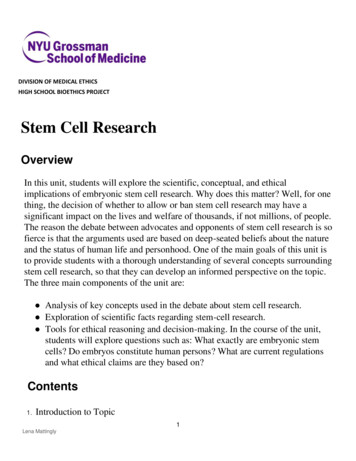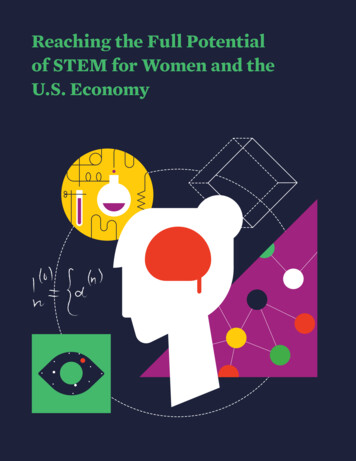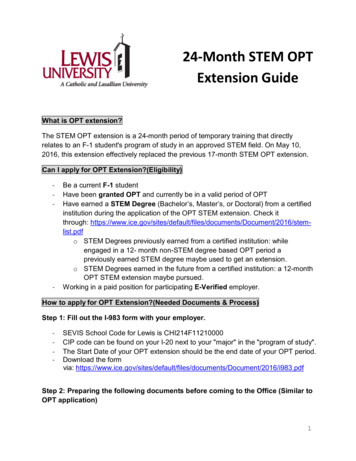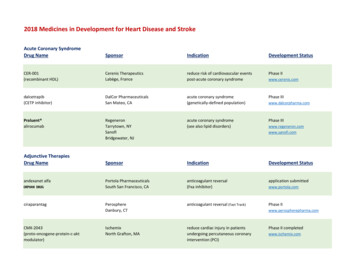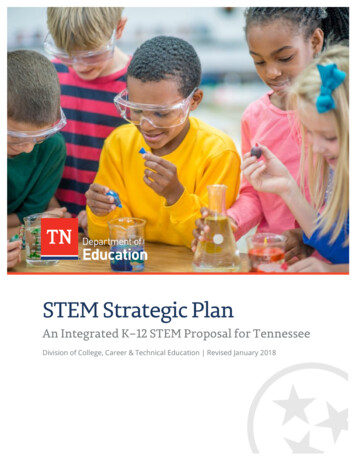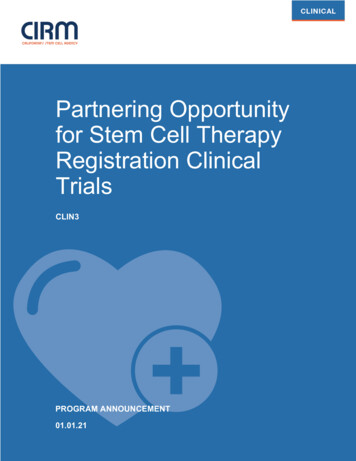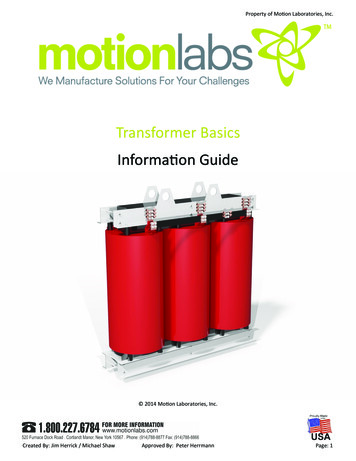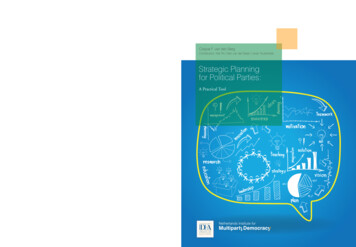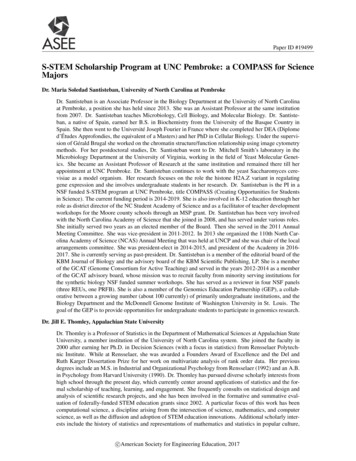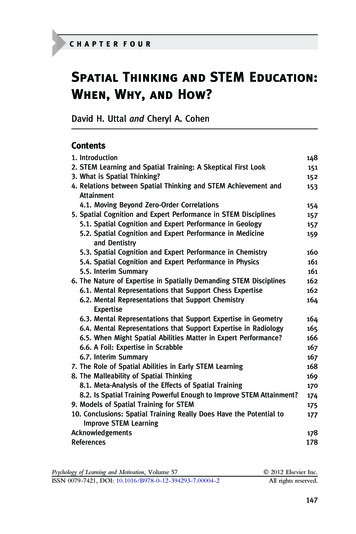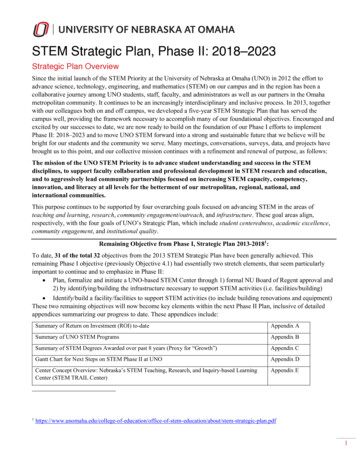
Transcription
STEM Strategic Plan, Phase II: 2018–2023Strategic Plan OverviewSince the initial launch of the STEM Priority at the University of Nebraska at Omaha (UNO) in 2012 the effort toadvance science, technology, engineering, and mathematics (STEM) on our campus and in the region has been acollaborative journey among UNO students, staff, faculty, and administrators as well as our partners in the Omahametropolitan community. It continues to be an increasingly interdisciplinary and inclusive process. In 2013, togetherwith our colleagues both on and off campus, we developed a five-year STEM Strategic Plan that has served thecampus well, providing the framework necessary to accomplish many of our foundational objectives. Encouraged andexcited by our successes to date, we are now ready to build on the foundation of our Phase I efforts to implementPhase II: 2018–2023 and to move UNO STEM forward into a strong and sustainable future that we believe will bebright for our students and the community we serve. Many meetings, conversations, surveys, data, and projects havebrought us to this point, and our collective mission continues with a refinement and renewal of purpose, as follows:The mission of the UNO STEM Priority is to advance student understanding and success in the STEMdisciplines, to support faculty collaboration and professional development in STEM research and education,and to aggressively lead community partnerships focused on increasing STEM capacity, competency,innovation, and literacy at all levels for the betterment of our metropolitan, regional, national, andinternational communities.This purpose continues to be supported by four overarching goals focused on advancing STEM in the areas ofteaching and learning, research, community engagement/outreach, and infrastructure. These goal areas align,respectively, with the four goals of UNO’s Strategic Plan, which include student centeredness, academic excellence,community engagement, and institutional quality.Remaining Objective from Phase I, Strategic Plan 2013-20181:To date, 31 of the total 32 objectives from the 2013 STEM Strategic Plan have been generally achieved. Thisremaining Phase I objective (previously Objective 4.1) had essentially two stretch elements, that seem particularlyimportant to continue and to emphasize in Phase II: Plan, formalize and initiate a UNO-based STEM Center through 1) formal NU Board of Regent approval and2) by identifying/building the infrastructure necessary to support STEM activities (i.e. facilities/building) Identify/build a facility/facilities to support STEM activities (to include building renovations and equipment)These two remaining objectives will now become key elements within the next Phase II Plan, inclusive of detailedappendices summarizing our progress to date. These appendices include:1Summary of Return on Investment (ROI) to-dateAppendix ASummary of UNO STEM ProgramsAppendix BSummary of STEM Degrees Awarded over past 8 years (Proxy for “Growth”)Appendix CGantt Chart for Next Steps on STEM Phase II at UNOAppendix DCenter Concept Overview: Nebraska’s STEM Teaching, Research, and Inquiry-based LearningCenter (STEM TRAIL Center)Appendix 1
Thanks to the tremendous team that helped to build this Strategic Plan, Phase II:Including co-authors, STEM Community Chairs: Christine Cutucache; Brian Dorn; Neal GrandgenettMichael Matthews; Chris Moore; Janice RechAnd STEM Leadership Team Members and STEM Contributors: Laura Alexander, Janelle Beadle,Catherine Co, Joshua Darr, Vanessa Denney, Carol Engelmann, Zachary Fowler, Michelle Friend, LendellHillhouse Jr., Kelly Gomez Johnson, Anne Karabon, David Kriegler, Amelia Lanier, Betty Love, MichaelMatthews, Sheryl McGlamery, Angela McGraw, Briana Morrison, Derrick Nero, Constance O'Brien, MichaelO'Hara, Mark Pauley, Christine Reed, Dana Richter-Egger, Robert Shuster, Harvey Siy, Amelia Squires,Rose Strasser, Kota Takahashi, Scott Tarry, James Taylor, Krista Testin, Sandy Vlasnik, Victor Winter,Vincent Woolf, & Jenna YentesAnd Thanks to the Additional STEM Supporters, Advisors, and Unit Chairs for Reviewing the STEMStrategic Plan, Phase II: John Conrad, Joyce Crockett, David Belieu, Joshua Darr, Sarah Edwards, GriffElder, Ann Fruhling, Deepak Khazanchi, John Konvalina, Richard Lomneth, Nicole Massara, DoraMatache, Sara Myers, Jim A Rogers, Renat Sabirianov, Julie Sigmon, Nicholas Stergiou, William Tapprich,Scott Vlasek, Peter Wolcott, L LaReesa Wolfenbarger, Jong-Hoon Youn, & Qiuming ZhuAnd Thanks to the STEM College Dean, whose vision and ongoing leadership and support createdand sustain the collaborative STEM Initiative at UNO: Hesham Ali, John Bartle, David Boocker, &Nancy EdickThe Foundation of STEM Success to DateIn 2011, UNO was designated a Carnegie Doctoral/Research University in recognition of the University’s evolutionfrom being primarily a teaching institution to one that offers research doctoral degrees in a range of fields. Since then,the University has made a focused effort to support and expand research endeavors across campus. In the 2012document, UNO Campus Priorities: Charting a Clear Vision for 20/20, “STEM” and “STEM Education” wereidentified as major initiatives within a campus-wide STEM Priority. Since then, a cohesive group of STEMCommunity Chairs, STEM department faculty, and STEM researchers have formed a very active and collaborativeSTEM Leadership Team, strongly supported by UNO administrators. This team, which has 57 members as of Spring2018, has aggressively pursued external funding for STEM efforts and is proud to report that external grants led bymembers of the STEM Leadership Team now represent 30–40% of UNO’s external funding in any given fiscal year.These grants help UNO faculty to expand existing and develop new innovative STEM initiatives, driving progress inSTEM teaching, research, and outreach efforts across campus and in the wider community. As a consequence of theseinitiatives, faculty contributions to the scholarship of teaching and learning (SoTL) and discipline-based educationresearch (DBER) continue to expand, elevating UNO’s national status as a leader in providing and promotingeffective P16 STEM education pathways from “cradle to career.”Collectively, over the last five years, UNO’s existing STEM initiatives account for over 32 million in extramuralfunding within the State of Nebraska over the past five years and address all four overarching goal areas identified inthe 2013 STEM Strategic Plan (i.e., teaching/learning, research, service/community engagement, STEMinfrastructure). A detailed Return on Investment (ROI) Document is provided in Appendix A. Many individual STEMinitiatives also combine teaching, research, and/or outreach activities, as illustrated in Figure 1. Further, we provide abrief sample of key accomplishments to date by goal area. Detailed summaries of “showcase” STEM initiatives,which collectively represent some of our best work to date, are provided in the attached STEM highlights document(Appendix B).2
Figure 1. Existing STEM projects (from Phase I).Teaching/Learning—Teams of UNO faculty have collaborated within and across departments and colleges, and withcommunity partners, to create new opportunities in support of engaged, student-centered teaching and learning in theSTEM disciplines at all levels of the P16 pipeline. Examples of new opportunities resulting from these collaborationsinclude the following: Dual pathways for STEM disciplinary degrees and teacher certification. Increased integration of inquiry-based learning in undergraduate coursework (e.g., Calculus, Biology,Engineering). Team-taught interdisciplinary courses focused on workforce development (e.g., Inquiry Learning in STEM atGlacier Creek) STEM-focused student support services (e.g., mentoring through NE STEM 4U, Learning Assistants at theundergraduate and graduate level for science coursework, Anatomy Academic Assistants, and Near-PeerTutors at the Health & Careers Resources Center). Disciplinary professional development opportunities and scholarships for pre-service teachers (e.g.,NoyceMATH, NoyceSCIENCE). New STEM programs in Computer Science (Supplemental Teaching Endorsement, M.S. in CS Education) A shared STEM Prefix that helps to support interdisciplinary instruction and collaborative workloads Disciplinary training and ongoing education for in-service teachers (e.g., Teacher-Researcher PartnershipProgram). New P12 STEM projects sponsored by area school districts (e.g., P12 Comprehensive Teaching & Learningprojects).3
These efforts have been made possible by the support from a variety of grants and contracts awarded to UNO facultyin the Colleges of Arts and Sciences, Education, and Information Science & Technology, and Public Affairs andCommunity Service from national agencies (e.g., NSF, NASA, Department of Labor) and local foundations (e.g.,Sherwood, Peter Kiewit Foundation), inclusive of STEM collaborations on grants with other NU campus as well.Research—Interdisciplinary faculty teams have also collaborated on a number of STEM-related DBER projects andhave created new opportunities to engage students in authentic research experiences in STEM. Examples include thefollowing: Faculty teams have conducted several research projects investigating innovative STEM learning environmentsin areas such as educational robotics, computer science, wearable technologies, and biomechanics education(including funding by five different NSF I-TEST awards, NSF DRK12, NSF ATE, NSF EAGER and NASA). UNO is the lead institution for the national Network for Integrating Bioinformatics into UndergraduateEducation (NIBLSE), an NSF-funded Research Coordination Network (RCN) for Undergraduate BiologyEducation focused on articulating a shared vision of the extent to which, and how best to, integratebioinformatics into life sciences curricula. Faculty mentors provide research-based instructional interventions to cohorts of students in STEM-relatedstudent organizations (e.g., NE STEM 4U) and scholarship programs (e.g., NoyceMATH, NoyceSCIENCE).In addition, faculty mentors coordinate internship opportunities with local and regional industry andcommunity partners. Faculty with active in-discipline research programs mentor undergraduate and graduate students in research(with support from UNO FUSE, NSF, NIH, and other extramural funds). Faculty also mentor in-service teachers in research through projects such as the Teacher-ResearcherPartnership Program (funded by the Sherwood foundation). UNO faculty have contributed to the development of new online courses, such as Research as a TransferrableSkill (to be made available through the Oxford University Press on the Epigeum online course platform), andblended courses, such as Data Driven Decision Making, that is a common course for STEM graduate studentsacross campus. STEM faculty regularly engage with students through journal clubs, directed reading or research activities. Faculty teams integrate research-based learning into innovative outreach initiatives designed to strengthen theP16 STEM pipeline (see Outreach/Community Engagement below).These practices are all consistent with Kuh’s High Impact Educational Practices (AAC&U), and they are contributingto increased student enrollment, retention, persistence, and completion in STEM (see Appendix C, STEM ProgressTables and Graphs). Furthermore, research-related STEM efforts are foundational to the 2018–2023 vision ofdesignating a STEM Center (see timeline in Appendix D and concept/proposal for a STEM Center in Appendix E).Service/Community Engagement—UNO has a long history of collaborating internally and with external partners toprovide innovative STEM outreach activities, and in 2016, the UNO STEM Leadership Team and Omaha CitywideSTEM Ecosystem received national recognition for their efforts, earning UNO an exemplary designation for the W.K.Kellogg Foundation’s Community Engagement Scholarship Award. Examples of the types of activities for whichUNO was recognized include the following: UNO STEM, along with the Henry Doorly Zoo and Aquarium and other city organizations, is a key foundingpartner for the Omaha Citywide STEM Ecosystem, which represents partners across education, business,industry, and non-profit sectors who share a vision to maximize STEM learning initiatives in the GreaterOmaha area from “cradle to career.”4
UNO STEM offers a wide variety of innovative educational programming to strengthen and expand the K12STEM pipeline, including afterschool programs (e.g., NE STEM 4U), on-campus events and summer camps(e.g., Code Crush, Chemistry Field Day, EUREKA, Aim for the Stars), and educational software and onlinelearning tools (e.g., Bricklayer). Such efforts are supported with funding from local, regional, and nationalorganizations (e.g., Sherwood Foundation, Peter Kiewit Foundation, Nebraska Department of Education,NSF, and school districts within the Metropolitan Omaha Education Consortium).Infrastructure—Over the last five years, UNO has recruited and supported a STEM Leadership Team, nownumbering 57 members, using an innovative and effective community chair model, who work closely with CollegeDeans and Department Chairs. This cross-college interdisciplinary leadership team has collaboratively with manySTEM colleagues and has established a productive record of program development, extramural funding, andeducational best practices that has radiated through academic units across campus and into partner organizationsacross the Omaha metropolitan area. Building on this foundation, UNO is prepared to move to the next level (PhaseII) in propagating successful models in STEM education.The 2018–2023 STEM Vision, Goals, and ObjectivesThe vision of this Phase II STEM Strategic Plan for 2018–2023 is to further strengthen and expand UNO’sSTEM infrastructure to support continued innovation and growth in STEM teaching, research, and outreachand to elevate UNO and the State of Nebraska to exemplary status in STEM, regionally and nationally.Going forward, the focus of our four overarching goals will remain the same as in the previous plan. We will continueto pursue innovative initiatives to advance STEM teaching and learning (Goal 1), research (Goal 2), andservice/community engagement (Goal 3), with many initiatives addressing more than one area (Figure 2). At the sametime, our objectives in all goal areas will be designed to strengthen and expand UNO’s STEM infrastructure (Goal 4)in support of a new STEM Center of Excellence. Specifically, the UNO STEM Leadership Team believes continuedprogress requires the organizational structure and funding possibilities of a designated STEM Center. Establishingsuch a Center will help launch a new trajectory, allowing UNO to recruit additional personnel and providing theoperational infrastructure that can also advocate for and help to plan the physical resources necessary to capitalize onexisting synergistic STEM initiatives across the region. The needs, demands, and opportunities associated withestablishing such a Center are articulated in a separate conceptual proposal for a new STEM Teaching, Research andInquiry-based Learning (STEM TRAIL) Center (provided here as Appendix E).5
Figure 2. Future STEM projects (some are already in progress at time of writing Phase II).The following objectives, organized by goal, represent the greatest future potential for further operationalizing andexpanding the STEM priority on campus as conceptualized by the STEM Leadership Team. In the context ofcontinued interdisciplinary conversation and collaboration, we seek to aggressively build on our strong foundation toincrease the return on investment for STEM initiatives and retrieve additional external funding dollars, striving formore than 90M over the next 5 years. It is important to note that, given the national STEM landscape at thisparticular time, UNO’s strong record of success in STEM, a strong base of metropolitan partnerships and the growingarray of external funding opportunities increasingly available in STEM, we collectively see these “stretch” objectivesas both appropriate and feasible.GOAL 1: TEACHING/LEARNING To strengthen the P16 STEM educational pipeline through innovative andinterdisciplinary UNO STEM learning initiatives and to thus increase interest, involvement, and success in the STEMdisciplines among all UNO students, especially those from underrepresented groups. To continue to build interdisciplinary synergy and STEM pathways to welcome all students into STEM, witha new and special attention provided to exceptional students, while recruiting, retaining, and graduating anincreased number and diversity of STEM students at UNO. To build a strategic professional development initiative that formalizes STEM instructional training forteaching assistants across STEM departments and colleges and that offers contractual services in STEMprofessional development to other universities and partners.6
To further expand the use of the STEM prefix as a catalyst to developing and offering innovative,interdisciplinary STEM coursework at both the graduate and undergraduate levels. To create interdisciplinary STEM courses, in areas such as high-altitude ballooning, that increasingly drawstudents into STEM educational pathways and future careers and that provide mechanisms for furtherinnovative STEM experiences, such as participation in NASA’s national CubeSat program or NASA- andNSF-related internships. To develop STEM graduate certificates, inclusive of Teaching Proficiency Certificates at the graduate levelfor UNO, University of Nebraska Medical Center (UNMC), University of Nebraska-Lincoln (UNL) and theUniversity of Nebraska at Kearney (UNK) for graduate students and post-docs. To help to support faculty training in innovative STEM pedagogies, with special attention to student researchexperiences, inquiry-based learning, and project-based learning. To expand the use of innovative STEM spaces for student learning and experiences, both on campus (such ascourses at Glacier Creek), and off campus (such as in STEM internships in businesses and communitycollaborators) and in partnership locations such as at the Omaha Henry Doorly Zoo and Aquarium. To work closely with the Metropolitan Omaha Education Consortium to further develop and to refine wellarticulated P16 pathways into UNO STEM programs.GOAL 2: RESEARCH To become a national leader in the research, development, and refinement of STEM activelearning models that particularly support student success in metropolitan settings across the P16 pipeline and intoSTEM careers. To further expand external funding for STEM initiatives. To establish a focused research commercialization and intellectual property effort for STEM initiatives(inclusive of patents on assessments, curriculum, process, product, and training programs). To educate faculty and to explore new funding opportunities for STEM educational programs, includingopportunities through the Department of Education, Department of Labor, and Department of Defense. To work closely with the University of Nebraska Foundation to help to identify and to apply for “seedfunding” for important STEM Initiatives, such as is possible with the Gates Foundation. To expand financial support for students in STEM disciplinary and STEM education pathways, includingwinning further external scholarship grants by focusing on related funding tracks in NSF, which considerssuch projects as STEM research intensive endeavors (Noyce Tracks II–IV and S-STEM Tracks II & IV). To serve as key partners for NSF Research Traineeship (NRT) awards with UNMC, UNL, or MetropolitanCommunity College (MCC), including partnering in specialized cross-institutional funding programs (such asthe NSF Advanced Technical Education program for community colleges and university collaborations). To partner with UNMC, UNL (especially Engineering and Social Sciences), UNK, MCC, and Iowa WesternCommunity College (IWCC) faculty to serve as the “Teaching Training or STEM Partner” for variousinitiatives, particularly for NIH and NSF research training grants for graduate students and post-doctoralfellows (e.g. NIH F31 and T32 awards).GOAL 3: SERVICE/COMMUNITY ENGAGEMENT To foster innovation in STEM service and communityengagement in STEM learning through active, synergistic, and sustainable partnerships with the broader STEMcommunity, including STEM educators, business professionals, and informal education partners. To further expand and strengthen the Omaha Citywide STEM Ecosystem, as a mechanism for shared growthin STEM “cradle to career” educational pathways in the city, with a focus on educational initiatives that7
integrate services and resources of partners across sectors, including those in formal education, informaleducation, business/industry, government, and community. To continue to partner aggressively with the Metropolitan Omaha Educational Consortium in STEM-relatedschool-district empowerment initiatives and particularly seek P16 external funding opportunities, such as forcollaborative after-school programs, summer enrichment, and STEM event opportunities for youth. To expand ongoing STEM outreach efforts, with a special priority on efforts that build the P16 STEMpipeline and UNO enrollment in STEM programs (including the incorporation of more partners). To expand UNO Citizen Science collaborations, that involve P16 students in collaborative research projectsthat directly serve the community.GOAL 4: STEM INFRASTRUCTURE To provide administrative leadership and support through a UNO STEMTeaching, Research, and Inquiry-based Learning Center to ensure continued growth and excellence in UNO STEMrelated teaching, research, and service initiatives. To establish a formalized UNO STEM TRAIL Center that includes focused organizational procedures,dedicated personnel and state-of-the-art facilities to facilitate efficient interdisciplinary collaboration acrosscolleges and departments and that will be a powerful catalyst to shared success across all campus units (seeSTEM TRAIL Center proposal for details). To leverage the expertise represented by UNO STEM to provide contractual services locally, regionally, andnationally for STEM-related training, professional development, instruction, or evaluation projects, therebygenerating revenue and the increasing national visibility of UNO STEM. To establish the infrastructure mechanisms for STEM Service Cost Centers with the UNO STEM communityto help colleges and departments more efficiently manage and support interdisciplinary STEM efforts. To increasingly work with the NU Foundation to showcase pilot STEM initiatives and studies at UNO and totransition successful pilot projects into sustainable, externally funded, national models of effective STEMprogramming. To seek opportunities to build initiatives that include traditionally non-STEM disciplines, such as in the FineArts and Music, as a source of STEM innovation, creativity, and collaboration for STEAM initiatives(STEM Art) and to increasingly draw upon the significant expertise of faculty with strong STEM skill setsacross all of UNO, such Economics or Entrepreneurship. To work closely with University Communications to publicize success stories of our STEM students (e.g.,Putnam Scholars, Noyce Scholars, NIH and NSF grant recipients) as a strategy for recruiting more students,attracting donors for scholarship funds, and increasing externally funded scholarship awards. To work closely with the STEM deans, the Associate Vice Chancellor for Research and Creative Activity,and others as needed to collaboratively build innovative and interdisciplinary faculty workload strategies,mentoring and policies to support increased grant funding competitiveness for individual investigators (e.g.,address existing challenges associated with NSF’s 2-month salary limitation).Final ThoughtThis set of Phase II goals and objectives for the STEM Strategic Plan is purposefully more limited and more focusedthan our Phase I goals and objectives. More context is explained in the appendices, but one common thread is in allelements: collaboration. We hope to build upon, innovate, and find strength in our interdisciplinary and communitycollaboration. Everyone is welcome to contribute to STEM learning for all and we are committed to inclusion whetherit be for the many students we have the honor to serve, or the many faculty, staff, administrators and community8
partners striving to serve them. A famous African Proverb states “that if you wish to go quickly, go alone, but if youwish to go far, then go together.” In UNO STEM, and in this new Phase II effort, we certainly wish to go collectivelyand to go far. Since its initiation in 2012, the UNO STEM Priority has focused on breaking down silos, both withinthe traditional STEM disciplines and with partners in other disciplines that perhaps see themselves as non-STEM. Wewelcome them to the STEM table. To the STEM Leadership Team and the many UNO colleagues and partnersworking on this shared effort, silos of any type in learning and innovation are counterproductive and undesired, nomatter their size. STEM is an inclusive campus priority, that we hope that it will empower all students (both currentand future) to achieve a brighter future and will support all faculty, staff, and community partners in helping thosestudents to succeed.9
Appendix ASummary of Return on InvestmentFollowing is a summary of the return on investment (ROI) to UNO and the NU System for grant writingrelated to STEM research over the last five years (i.e., during implementation of the Phase I STEM StrategicPlan). It is from the collaborative portal of the STEM Community Chairs, including STEM research effortsthat the Chairs helped to lead or to facilitate on behalf of the STEM Leadership Team, withacknowledgement and appreciation that the UNO/NU teams have involved many different departments,faculty colleagues, and Nebraska partners.Five Years of Funded STEM Community Chair Grants (2012–2017)Project Name AmountTimeframeNSF SPIRIT and SPIRIT 2.0 CEENBot 3.1 M2008–2013NSF Project SHINE 1.1 M2010–2012NSF Integrating Bioinformatics into Life Sciences Education 600K2011–2014NSF Research Experiences for Teachers Mobile 500K2012–2015NSF IMPART Research Experiences 449,0002012Girls, Inc. EUREKA! 38,6002012NSF GearTec 21 Robotics: ITEST 1.1 M2013–2015NSF GearTec Scale Up Robotics: ITEST 2.3 M2014–2019NSF NE Math Omaha Noyce: Noyce 1.1 M2014–2019NSF WearTec: ITEST Wearable Tech 1.2 M2015–2017NSF SPARCS CS Ed: ITEST CS Teacher Workshops 1.12015–2017NSF Bioinformatics Ed: RCN 499K2015–2020Girls, Inc. EUREKA! 79,9562015NSF Research Exp Teachers CS: 500K2017–2019NSF NEScience Noyce 1.2 M2017–2022NSF Telepresence Robots in Ed: EAGER 300K2017–2018NSF BODYMODELS: ITEST 1.2 M2018–2020NSF EAGER NE Innovative Maker Co-Lab 300,0002017NE Department of Labor NE’s IT Educational Pathway 9,162,6802014–2018NE Online Worldwide CSE 35,0002013–2016Sherwood Foundation CSE for In-service Teachers 97,7692016–2019NSF EXP RUI 448,6982013–2017NSF CER 442,3012013–2016Google CS4HS@UNO 35,0002014NSF RCN-UBE NIBLSE 49,8902014Girls, Inc. EUREKA! STEM 80,0002016, 2017Sherwood Foundation K-12 Comprehensive Science 4.2M2014–2018Sherwood Foundation TRPP 628,2082015–2018Sherwood Foundation NE STEM 4U 381,9412012–2018Peter Kiewit Foundation NE STEM 4U 62,6642015–2018NSF RCN-UBE 499,9372015–2019USDE NE SciLEAD 15,0002017–2018Total awarded 32,886,644 – ( 203,500 CC endowment grant writers) ROI 32,683,144NOTE: ROI Calculation [(Total extramural grantfunding, not inclusive ofcontracts nor indirect costsfrom the 3 STEM CommunityChairs (i.e., in TeacherEducation, ComputerScience, and Science) from2012–2017 less the cost ofthe Community Chair annualendowment)]. The researchand service time of CommunityChairs is not included as suchtime is part of their 9-monthfaculty appointment withindepartmental units (i.e., 25–50% research assignment).The totals are less theCommunity Chair yearlyendowment and the Universitysupported resources for agiven project (if provided, e.g.,funding for a grant writer ifmatched from a UNO source).Only funds obtained, notinclusive of submitted but notsuccessful proposals, areincluded. The ROI excludescontracts and in-kind work(above workload) that has ledto additional significant costsavings to the university foritems purchased from vendors(e.g., FlowJo, Epigeum,amongst others).A-1
Appendix BA Glimpse of UNO STEM ProgramsUNO has numerous showcase STEM programs underway representing growth, innovation and collaborationin STEM teaching, research, and outreach. The highlighted programs described below provide a briefglimpse of UNO STEM in action.The UNO Putnam ScholarsLed by senior faculty in the UNO Mathematics Department, UNO teams frequently place highly on theprestigious Putnam Competition, held annually for the top undergraduate mathematics students in the U.S.and Canada. The competition began officially in 1938 but has origins as far back as 1933 when 10 studentsfrom Harvard competed against 10 students fromthe United States Military Academy at WestPoint. The competition consists of two, threehour sessions of six math problems, which aregraded on a scale of 0-10 points. Competitorsmust show the steps in their work to justify ananswer and receive full credit, and partial creditmay be given only when showing significantprogress towards the solution. Sponsored by the Mathematical Association of America, the competition hascounted many distinguished mathematicians and scientists among its participants over the years, includingNobel Prize winner John Nash, noted for his work in game theory and differential equations and the subjectof the 2001 Hollywood film “A Beautiful Mind.” UNO teams routinely do quite well in this mo
teaching and learning, research, community engagement/outreach, and infrastructure. These goal areas align, respectively, with the four goals of UNO's Strategic Plan, which include student centeredness, academic excellence, community engagement, and institutional quality. Remaining Objective from Phase I, Strategic Plan 2013-20181:
